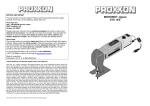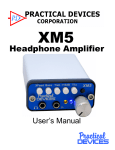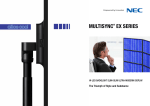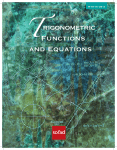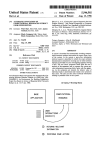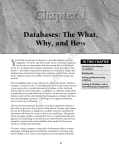Download Epson QX-10 User`s guide
Transcript
EPSON QX-10 MICROCOMPUTER SYSTEM TRAINING PROGRAM DECEMBER 1983 SBXEBT030 Published by: Xerox Corporation, Rochester, New York 14644 Prepared by: Multinational Documentation and Training Services Xerox Corporation, Rochester, New York 14644 Copyright 1983 by Xerox Corporation. All rights reserved. XEROX is a trademark of Xerox Corporation QX-IO is a registered trademark of Epson America, Inc. TABLE OF CONTENTS PROGRAM OVERVIEW •••••••••••••••••••••••••• Module 1, Introduction ••••••••••••••• Module 2, Installation and Operation. Module 3, Service Documentation. Module 4, Troubleshooting •• Prerequisites •••••••••••••• Program Objectives ••••••••• Estimated Completion Time •• Required Resources ••• Program Instructions ••••••• 1 1 1 1 1 MODULE 1, INTRODUCTION •• Module Overview •• Prerequisites •••••• Module Objective ••• Estimated Completion Time •• Self-Test 'I •• Feedback #1 •• 3 3 3 3 3 5 MODULE 2, INSTALLATION AND OPERATION •• Module Overview •• Prerequisite ••••••••••••••• Module Objective ••••••••••• Estimated Completion Time •• Self-Test 12 ••••••• Feedback #2 •• 2 2 2 2 2 6 7 7 7 7 7 9 • .10 MODULE 3, SERVICE DOCUMENTATION. Module Overview •• Prerequisite ••••••••••••••• Module Objective ••••••••••• Estimated Completion Time •• Self-Test f3 •• Feedback #3 ••• • .14 MODULE 4, TROUBLESHOOTING. Module Overview •• Prerequisite ••••••••• Module Objective ••••• Estimated Completion Time •• Submodule 1 •• Submodule 2 •• Submodule 3 •• Submodule 4 •• Self-Test #4 •• Feedback 14 ••• .15 .15 .15 . .... .. 15 .15 .16 .17 .18 .19 ..20 ..21 1 .11 .11 .11 .11 .11 .13 PROGRAM OVERVIEW This training program will prepare you to service the Epson QX-IO microcomputer system. You will learn how to use the service documentation for troubleshooting, removal and replacement of parts and adjustments. This program is divided into the following modules. MODULE 1 INTRODUCTION This module gives an overview of the hardware and software aspects of the QX-IO. It will contain information about the unique features of the QX-IO which are not common to most other microcomputers. MODULE 2 INSTALLATION & OPERATION In this module, you will learn to install and verify the basic operation of the microcomputer. MODULE 3 SERVICE DOCUMENTATION This module discusses the Epson QX-IO technical manuals and introduces you to the service documentation. MODULE 4 TROUBLESHOOTING In this module, you will learn how to use the documentation to troubleshoot down to the smallest assembly shown in the parts lists with a Xerox part number. 1 PROGRAM OVERVIEW PREREQUISITES You must have successfully completed the generic training program for microcomputers. PROGRAM OBJECTIVES You will be able to state, in writing, what troubleshooting techniques, repair procedures, and adjustments are unique to the QX-IO microcomputer. You will also be able to state, in writing, what the software and hardware differences are between the QX-IO and most other microcomputers. ESTIMATED COMPLETION TIME 2 hours REQUIRED RESOURSES QX-IO Service Documentation PROGRAM INSTRUCTIONS Complete the modules at a pace that is comfortable for you. The estimated time to complete this program is approximate and you may take more or less time to complete it. This manual is reusable. Do not write in it. Answer all questions on a separate piece of paper. Feedback (answers) to the questions can be found at the end of each module. Proceed through the modules in order and follow all directions. This training program does not require that you have an Epson QX-IO microcomputer available. However, if a system is available, you may use it as a resource while completing any part of the program. You must not miss more than one question per module. If a question has more than one part, one of the parts will be considered one question. If you miss more than one question per module, review the information you missed and try the Self-Test again. 2 MODULE " INTRODUCTION MODULE OVERVIEW This module will give you an overview of the hardware and software aspects of the QX-IO. It will contain information about the unique features of the QX-IO which are not common to most other microcomputers. PREREQUISITE Completion of the COURSE OVERVIEW. MODULE OBJECTIVE At the end of this module, you will be able to answer questions about the hardware and software differences between the QX-IO and most other microcomputers. You can use the service documentation as a resourse for information. You can also use a QX-IO, if available. ESTIMATED COMPLETION TIME 15 minutes 3 MODULE 1, INTRODUCTION Like the 820, the QX-IO system consists of a keyboard, monitor, and disk drive. However, unlike the 820, the QX-IO is a TPM* or CP/M* based microcomputer. The 820 and most other microcomputers presently use the CP/M operating system. TPM will run any application program written for CP/M. However, applications programs written for TPM may not run on a CP/M system. The customer can request either operating system before taking delivery of a QX-IO. Epson can also supply either the ASCII or HASCI* keyboard configuration with the QX~lO, per customer request. HASCI (pronounced "has-key") is an acronym for "Human Applications Standard Computer Interface." The two keyboards have key layouts that look similar, but the four sets of keys at the top of the HASCI keyboard are for system control. For example, in HASCI, one of the system control keys is used to initiate copying a disk. In ASCII, more keys are required for the same function. HASCI was designed to be more "friendly" to the user. A plug with eight pins and a coiled cord connects the keyboard and disk drive. The monitor is unique because the circuitry can use and display two modes at the same time; characters and graphics. The circuitry for that function is in the disk drive unit. The monitor can also zoom and scan like a TV camera. A short straight cord connects the monitor and disk drive. One end has eight pins and the other end has seven pins. The disk drive contains the microprocessor, video circuitboard, five circuitboard slots for options, low voltage power supply and of course the left and right disk drives. The monitor produces the high voltage needed for the CRT. *TPM is a registered trademark of Computer Design Labs *CP/M is a registered trademark of Digital Research *HASCI isa registered trademark of Rising Star Industries 4 MODULE 1, INTRODUCTION SELF-TEST 11 Answer the following questions on a separate sheet of paper. Do not write in this book. After you have answered" the questions, check your answers with the feedback on the next page. 1. The QX-IO can be equipped with one, two, or three operating systems? 2. What are the names (acronyms) of the keyboard configurations that are available for the QX-IO? 3. Can the monitor zoom? 4. Are there circuitboard slots for options in the monitor? 5 MODULE " INTRODUCTION FEEDBACK 11 This page contains the feedback for the questions at the end of MODULE 1. 1. The QX-IO can be equipped with either of two operating systems, TPM or CP/M. 2. HASCI and ASCII are the names (acronyms) of the keyboard configurations available for the QX-IO. 3. Yes, the monitor can zoom. 4. No, the circuitboard slots for options are in the disk drive. Did you assume the last word in question four is disk drive? 6 MODULE 2, INSTALLATION & OPERATION MODULE OVERVIEW This module will tell you how to install and verify the basic operation of the QX-I0. PREREQUISITE Completion of the COURSE OVERVIEW MODULE OBJECTIVE At the end of this module, you will be able to answer three questions about how to connect the QX-I0 system together and check the basic operation. ESTIMATED COMPLETION TIME 15 minutes 7 MODULE 2, INSTALLATION & OPERATION Like most other microcomputers, The QX-IO requires interconnecting power cords among the keyboard, monitor, disk drive, and AC power source. Three cords are required and they are not interchangeable among the QX-IO units. Therefore, you can not connect the QX-IO units together incorrectly. The monitor cord is the shortest of the three cords and has a slightly different plug at each end. The plugs differ only in the number of pins. The end that connects into the rear of the monitor has seven pins, and the end that connects into the disk drive has eight pins. The connections are made at the rear of both units. The keyboard cord is coiled and has the same connector at each end. The connectors are similar to the connectors on the monitor. One end connects into the rear of the keyboard and the other end connects into the front of the disk drive. At this point in our discussion, the disk drive is connected to the monitor and keyboard. The disk drive also receives AC power from the AC power cord. One end of the cord connects to the AC power source, and the other end connects to the rear of the disk drive. Before connecting the power cord, be sure that the power is switched off. The power switch is on the side of the disk drive, near the power cord connector. In order to verify the basic operation of the QX-lO, the monitor, keyboard, disk drive, and power source must be connected. The basic operation can now be verified by switching the power on and observing the following visible and audible indications. The power-on LED, on the front of the disk drive, will glow. The cooling fan on the rear of the disk drive can be heard or the air flow can be felt. The keyboard keys, with red lights in them, will blink on and off in sequence. The LED on the left disk drive will glow brightly and the LED on the right disk drive will glow dimly. The message "INSERT DISKETTE" will appear on the CRT. If any of the above indications do not occur, there is a problem with the basic operation of the QX-IO that will be discussed in MODULE 4. 8 MODULE 2, INSTALLATION & OPERATION SELF-TEST #2 Answer the following questions on a separate sheet of paper. Do not write in this book. After you have answered the questions, check your answers with the feedback on the next page. 1. Can the QX-IO system be incorrectly connected together? 2. Is it neccessary to connect the QX-IO system together with a power source in order to verify basic operation? 3. One of the following conditions is not an indication of correct basic operation after power has been applied to the QX-IO. Which letter corresponds to the incorrect indication. A. The power-on LED on the front of the disk drive will glow. B. The cooling fan on the rear of the disk drive can be heard or the air flow can be felt. C. The keyboard keys, with red lights in them, will blink on and off in sequence. D. The audible tone generator will emit two short "beeps". E. The red indicator on the left disk drive will glow brightly and the indicator on the right disk drive will glow dimly. F. The message "INSERT DISKETTE" will appear on the CRT. 9 MODULE 2, INSTALLATION & OPERATION FEEDBACK ,2 This page contains the feedback for the questions at the end of MODULE 2. 1. NO, the QX-I0 system can not be incorrectly connected together. 2. YES, it is necessary to connect the QX-I0 system together with a power sourse in order to verify basic operation. 3. The letter D corresponds to the incorrect indication. Incidently,-checkout of the audible tone generator will be covered in MODULE 4. 10 MODULE 3, SERVICE DOCUMENTATION MODULE OVERVIEW This module will introduce you to the service documentation. PREREQUISITE Completion of the COURSE OVERVIEW. MODULE OBJECTIVE At the end of this module, you will be able to answer four questions about what is contained in the Troubleshooting Manual, Parts List, and the Computer Diagnostic Manual. You will also be able to write the names of the technical manuals that Epson has published for the QX-IO. ESTIMATED COMPLETION TIME 15 minutes 11 MODULE 3, SERVICE DOCUMENTATION Now we will look at what is contained in the Troubleshooting Manual. [] Open the cover and read "the Table of Contents. Then read the content pages of the five chapters in the Troubleshooting Manual. As you may have guessed by now, there is more information in this manual than you will need. No problem. Too much information is better than not enough information. However, you might expect to find adjustment information for the monitor in the manual and it is not there. That situation will be discussed later. The Price List contains what the name implies. Look through the price lists and notice what spare parts are available with Xerox part numbers. These are the assemblies that you will replace after troubleshooting. So you can say those assemblies are the "level of repair" to which. you will troubleshoot. For example, a circuitboard is the level of repair you will deal with for some problems. If the price list shows components on the circuitboards with prices, you would be dealing with a lower level of repair. The Computer Diagnostic Program Manual contains a diagnostic disk that is used for system checkout. The use of the disk is explained in the diagnostic program manual, and is used with the Troubleshooting Manual. Epson publishes a Principals of Hardware Operations that contains a detailed account of the theory of operation of the QX-IO. You do not need to use the theory of operation for your diagnostic needs. In summary, the following technical manuals have been published for the QX-IO by Epson, which does not include software manuals. QX-IO Technical Manual on Troubleshooting QX-IO Technical Manual on Principals of Hardware Operations Epson Computer Diagnostic Programs Price List 12 MODULE 3, SERVICE DOCUMENTATION SELF-TEST 13 Answer the following questions on a separate sheet of paper. Do not write in this book. After you have answered the questions, check your answers with the feedback on the next page. 1. Is general information, such as the weight of the system, available in the troubleshooting manual? 2. Where is information available about removing a disk drive? 3. Does the Price List contain more parts than there are Xerox part numbers? 4. What are the names of the technical manuals that have been published for the QX-IO by Epson? 13 MODULE 3, SERVICE DOCUMENTATION FEEDBACK ,3 This page contains the feedback for the questions at the end of MODULE 3. 1. YES, general information is available, such as the weight of the system, in Chapter 1. 2. CHAPTER 2 contains information about removing a disk drive. 3. YES, there are more parts than Xerox part numbers In the Price List. 4. The following technical manuals have been published for the QX-I0. TROUBLESHOOTING PRINCPALS OF HARDWARE OPERATION DIAGNOSTIC-PROGRAMS PRICE LIST 14 MODULE 4, TROUBLESHOOTING MODULE OVERVIEW This module will tell you how to troubleshoot the QX-IO. PREREQUISITE Completion of MODULE 2 and 3. MODULE OBJECTIVE At the end of this module, you will be able to answer five questions, in writing, about what the visible and audible indications of basic operation indicate. You will also be able to answer four questions, in writing, about the flowcharts in the Troubleshooting Manual and the Diagnostic Program Manual and Diagnostic Disk. ESTIMATED COMPLETION 1 hour 15 MODULE 4, TROUBLESHOOTING Troubleshooting will be discussed in the three submodules listed below. This was done to present the information in a more organized manner for your study purposes. However, the information in the submodules is interrelated and how it interrelates will become obvious as you proceed through them. SUBMODULE 1: Contains information about basic operation indications. SUBMODULE 2: Contains information about the flowcharts in the Troubleshooting Manual. SUBMODULE 3: Contains information about the Diagnostic Program Manual and Diagnostic Disk. SUBMODULE 4: Contains miscellaneous information about the Troubleshooting Manual. SUBMODULE 1 In Module 2, you learned what visible and audible indications to look for in order to verify basic operation of the QX-IO system. The visible and audible indications provide clues about what is right or wrong with some functions of the system, before using the Troubleshooting Manual to find out exactly what the problem is. The indications are useful as clues for troubleshooting because they are easy to check. The indications occur or will not occur within a few seconds after power is applied, and will help you understand where the Troubleshooting Manual is taking you. Also, with enough experience fixing the QX-lO, you will be able to use the basic operation indications as a troubleshooting tool to fix the QX-lO most of the time. Listed below are the visible and audible indications and what they indicate about basic operation. Power-on LED glows: Power supply is producing voltage. Cooling fan operates (you can hear the fan or feel the airflow): Power supply is producing voltage. Keyboard keys with indicators blink: Keyboard has voltage and self-test has been performed within the keyboard. Left disk drive LED glows brightly and right disk drive LED glows dimly: Voltage has reached the disk drives. "INSERT DISKETTE" appears on monitor: Voltage has reached the monitor and the monitor is producing high voltage. The CRTC on the video circuitboard in the disk drive is functioning. 16 MODULE 4, TROUBLESHOOTING SUBMODULE 1 (continued) Here is an example of how you can get a clue about a possible problem in the QX-IO by knowing what the basic operation indicators mean. As you have read, when the power-on LED on the disk drive glows after switching on the system, it means that the power supply is providing voltage. At the same time, the cooling fan should operate, also indicating the power supply is providing voltage. If however, the keyboard keys do not blink, you know something is wrong. You also know that the power supply is operating because the power-on LED and fan are on. Therefore, either the voltage is not getting to the keyboard, or the voltage is getting there, but the keyboard is not using the voltage properly. If the coiled cord from the disk drive to the keyboard looks good and is not damaged, the voltage is getting there, so the keyboard is probably the problem. The deductions you made in this example could take place in your mind before you get the Troubleshooting Manual open. And now you would have a good idea where the Troubleshooting Manual will take you, simply because you know what the indications of basic operation mean. SUBMODULE 2 This module will discuss the flowcharts in the Troubleshooting Manual which are what you will use to diagnose problems in the QX-lO. The flowchart you will always use first is called the Check-out Procedure. There are a total of eight flowcharts you may need to diagnose problems. There are more flowcharts in the manual, but you will not need them. The other flowcharts diagnose problems to components on the circuitboards, but you will replace only the circuitboard. In other words, the other flowcharts go beyond the level of repair you will deal with. [] Read the Check-out Procedure on page 5-2 in the Troubleshooting Manual. If you have not seen flowcharts before, I'm sure you quickly realized that a statement within a square is an action you must perform, and a statement within a diamond is an action you must observe with a yes (y) or no (N) result. Also, the pointed boxes with numbers in them are called drop-ins and drop-outs. These boxes connect the flowcharts together for some of the problems. For example, if you end up in a numbered box while finding a problem, you "drop out" to a drop-in box, in one of the other flowcharts with the same number. 17 MODULE 4, TROUBLESHOOTING SUBMODULE 2 (continued) [ ] Read the first box under drop-in 3.1 on page 5-4 in the Troubleshooting Manual. The action to perform, if you were repairing a system, would introduce the next submodule. SUBMODULE 3 Another diagnostic tool for the QX-IO is the Diagnostic Disk contained in the Diagnostic Programs Manual. As you have just read in the flowchart, you will be instructed when to use the Diagnostic Disk. In order to use the Diagnostic Disk, the left disk drive must work, so the flowcharts, as you have guessed, will not ask you to run the disk until the disk drives function. The monitor, power supply, and some parts of the microprocessor must also function. The Diagnostic Disk prompts you for the tests you wish to run. Below is a list of the tests available on the disk, as shown on the monitor. KEYBOARD TEST DISPLAY n FLOPPY n PRINTER n CMOS n ALL n EXIT TO SYSTEM FLOPPY DISK REPEAT TEST Without explaining the error codes that are detailed in the Diagnostic Program Manual, an error in a given test usually indicates a malfunction in the tested component. Running the disk is also a convenient means of verifying repairs. You can use the diagnostic disk in place of a system disk when the flowcharts direct you to check if the disk drive can read a disk. However, you should have a copy of the diagnostic disk in case the disk drive that you are checking is defective and erases the disk. Insert a disk with the read/write notch in and the write protect notch to your left. 18 MODULE 4, TROUBLESHOOTING SUBMODULE 4 As mentioned in Module 3, there is no adjustment information for the monitor in the Troubleshooting Manual. However, adjustment pots are in the monitor and you may apply your skills learned in the generic training program to use them. The Troubleshooting Manual contains adjustment information for the disk drives, but you are not required to use it. If you feel you can repair the unit using the tools you have, then do so. Test points are well marked on the circuitboards. There is test point and connector identification information in the Principals of Hardware Operations if you need it, but the hardware is well laid out and may make reference unnecessary. The tone generator should be heard when the diagnostic test selection prompt appears on the monitor. As a final note, you might suggest that the customer bring their User's Guide with them to the service center when they come in to have their system repaired. The User's Guide, supplied with the customer's system, may contain information you need about changes that have occurred during the ongoing product development and manufacturing cycles. 19 MODULE 4, TROUBLESHOOTING This page is intentionally left blank. 20 MODULE 4, TROUBLESHOOTING SELF-TEST 14 Answer the following questions on a separate sheet of paper. Do not write in this book. After you have answered the questions, check your answers with the feedback on the next page. 1. What do each of the following visible and audible indications mean? A. Power-on LED glows: B. Cooling fan operates: C. Keyboard keys with indicators blink: D. Left disk drive LED glows brightly and right disk drive LED glows dimly: E. "INSERT DISKETTE" appears on CRT: 2. Would you go to any flowchart to identify a problem? 3. How many of the flowcharts will you use to identify problems? 4. Does the power supply have to function in order to use the Diagnostic Disk? 5. Are you required to adjust the disk drives? 21 MODULE 4, TROUBLESHOOTING FEEDBACK ,4 This page contains the feedback for the questions at the end of MODULE 3. 1. A. Power supply is producing voltage. B. Power supply is producing voltage. C. Keyboard has voltage and self-test has been performed. D. Voltage has reached the disk drives. E. Voltage has reached the monitor and the monitor is producing high voltage. The CRTC on the video circuitboard in the disk drive is functioning. 2. No, I would go to the Check-out Procedure. 3. Eight of the flowcharts should be used. 4. Yes, the power supply has to function to run the disk. 5. No, the SCT is not required to adjust the disk drives. 22

























